A Study of Physico-Mechanical Properties of Hollow Glass Bubble, Jute Fibre and Rubber Powder Reinforced Polypropylene Compounds with and without MuCell® Technology for Lightweight Applications
Abstract
1. Introduction
2. Materials and Methods
2.1. Materials
2.2. Sample Preparation
2.3. Characterisation
2.3.1. Morphology and Filler Dispersion
2.3.2. Density Measurement
2.3.3. Mechanical Tests
2.3.4. Rheology
2.3.5. Melt Flow Index (MFI) Measurement
3. Results
3.1. Interfacial Morphology and Filler Dispersion of Materials
3.2. Density
3.3. Rheological Properties
3.4. Mechanical Properties
4. Conclusions
- The combination of filler hybridisation and MuCell® technology can lead to a total weight reduction of up to 20% when compared to the current plastic materials available on the market. For instance, replacing PP Current with GB3 using conventional moulding or with GB2 using MuCell® moulding can lead to a weight reduction of 18.7% and 16.4%, respectively.
- Owing to the incorporation of high-stiffness glass bubbles and reinforcing jute fibres, the newly developed PP compounds manufactured by conventional moulding exhibited increased tensile and flexural modulus and strength compared to PP Current, which is currently used for automotive components.
- Materials fabricated by MuCell® exhibited some deterioration in their tensile modulus, tensile breaking strain, and impact strength, but they still possess acceptable mechanical properties for automotive applications.
- Investigating the influence of shear rate on the viscosity of compounded materials revealed that highly filled compounds (JUTE2 and JUTE3) experience an earlier drop in viscosity with increasing shear rate, probably due to the breakdown of the networks formed by the high aspect ratio fibrous fillers.
Supplementary Materials
Author Contributions
Funding
Acknowledgments
Conflicts of Interest
References
- Reducing CO2 Emissions from Passenger Cars. Available online: https://ec.europa.eu/clima/policies/transport/vehicles/cars_en (accessed on 16 September 2020).
- Mock, P. CO2 Emission Standards for Passenger Cars and Light-Commercial Vehicles in the European Union; ICCT: Berlin, Germany, 2014; Available online: http://theicct.org/eu-co2-standards-passenger-cars-and-lcvs (accessed on 17 September 2019).
- Martini, J.E. The Production and Analysis of Microcellular Foam. Master’s Thesis, Massachusetts Institute of Technology, Department of Mechanical Engineering, Cambridge, MA, USA, 1981. [Google Scholar]
- Hayashi, H.; Mori, T.; Okamoto, M.; Yamasaki, S.; Hayami, H. Polyethylene ionomer-based nano-composite foams prepared by a batch process and MuCell® injection molding. Mater. Sci. Eng. C 2010, 30, 62–70. [Google Scholar] [CrossRef]
- Gómez-Monterde, J.; Hain, J.; Sánchez-Soto, M.; Maspoch, M.L. Microcellular injection moulding: A comparison between MuCell process and the novel micro-foaming technology IQ Foam. J. Mater. Process. Technol. 2019, 268, 162–170. [Google Scholar] [CrossRef]
- Li, J.; Chen, Z.; Wang, X.; Liu, T.; Zhou, Y.; Luo, S. Cell morphology and mechanical properties of microcellular Mucell® injection molded polyetherimide and polyetherimide/fillers composite foams. J. Appl. Polym. Sci. 2013, 130, 4171–4181. [Google Scholar] [CrossRef]
- Liu, T.; Liu, H.; Li, L.; Wang, X.; Lu, A.; Luo, S. Microstructure and properties of microcellular poly (phenylene sulfide) foams by Mucell injection molding. Polym. Plast. Technol. Eng. 2013, 52, 440–445. [Google Scholar] [CrossRef]
- Malacari, P.E. Talc in automotive applications. In Proceedings of the 8th Chinese Industrial Minerals Conference, Qingdao, China, 7–9 September 2009; pp. 1–10. [Google Scholar]
- Rudolf, R. General overview of the compounding process: Tasks, selected applications, and process zones. In Co-Rotating Twin-Screw Extruder; Kohlgrüber, K., Ed.; Hanser: Cincinnati, OH, USA, 2008; pp. 57–89. [Google Scholar]
- Franciszczak, P.; Merijs-Meri, R.; Kalniņš, K.; Błędzki, A.K.; Zicans, J. Short-fibre hybrid polypropylene composites reinforced with PET and Rayon fibres – Effects of SSP and interphase tailoring. Compos. Struct. 2017, 181, 121–137. [Google Scholar] [CrossRef]
- Fu, S.-Y.; Lauke, B.; Mäder, E.; Yue, C.-Y.; Hu, X. Tensile properties of short-glass-fiber and short-carbon-fiber-reinforced polypropylene composites. Compos. Part A Appl. Sci. Manuf. 2000, 31, 1117–1125. [Google Scholar] [CrossRef]
- Liang, J.Z. Impact fracture toughness of hollow glass bead-filled polypropylene composites. J. Mater. Sci. 2007, 42, 841–846. [Google Scholar] [CrossRef]
- Yalcin, B.; Amos, S.E. Hollow glass microspheres in thermoplastics. In Hollow Glass Microspheres for Plastics, Elastomers, and Adhesives Compounds; Amos, S.E., Yalcin, B., Eds.; William Andrew Publishing: Oxford, UK, 2015; pp. 35–105. [Google Scholar]
- Lee, P.C.; Wang, J.; Park, C.B. Extrusion of microcellular open-cell LDPE-based sheet foams. J. Appl. Polym. Sci. 2006, 102, 3376–3384. [Google Scholar] [CrossRef]
- Gogoi, R.; Kumar, N.; Mireja, S.; Ravindranath, S.S.; Manik, G.; Sinha, S. Effect of Hollow Glass Microspheres on the Morphology, Rheology and crystallinity of short bamboo fiber-reinforced hybrid polypropylene composite. JOM 2019, 71, 548–558. [Google Scholar] [CrossRef]
- Hasan, M.; Islam, M.N. Physico-mechanical properties of jute fiber reinforced polypropylene composites. J. Reinf. Plast. Compos. 2009, 29, 445–455. [Google Scholar] [CrossRef]
- Raghavendra, G.; Ojha, S.; Acharya, S.K.; Pal, S.K. Jute fiber reinforced epoxy composites and comparison with the glass and neat epoxy composites. J. Compos. Mater. 2014, 48, 2537–2547. [Google Scholar] [CrossRef]
- Rana, A.K.; Mandal, A.; Bandyopadhyay, S. Short jute fiber reinforced polypropylene composites: Effect of compatibiliser, impact modifier and fiber loading. Compos. Sci. Technol. 2003, 63, 801–806. [Google Scholar] [CrossRef]
- Dhakal, H.N.; Zhang, Z.Y.; Richardson, M.O.W. Effect of water absorption on the mechanical properties of hemp fibre reinforced unsaturated polyester composites. Compos. Sci. Technol. 2007, 67, 1674–1683. [Google Scholar] [CrossRef]
- Wambua, P.; Ivens, J.; Verpoest, I. Natural fibres: Can they replace glass in fibre reinforced plastics? Compos. Sci. Technol. 2003, 63, 1259–1264. [Google Scholar] [CrossRef]
- Sanjay, M.R.; Arpitha, G.R.; Yogesha, B. Study on mechanical properties of natural—Glass fibre reinforced polymer hybrid composites: A review. Mater. Today Proc. 2015, 2, 2959–2967. [Google Scholar] [CrossRef]
- Beckermann, G.W.; Pickering, K.L. Engineering and evaluation of hemp fibre reinforced polypropylene composites: Fibre treatment and matrix modification. Compos. Part A Appl. Sci. Manuf. 2008, 39, 979–988. [Google Scholar] [CrossRef]
- Inácio, A.L.N.; Nonato, R.C.; Bonse, B.C. Recycled PP/EPDM/talc reinforced with bamboo fiber: Assessment of fiber and compatibilizer content on properties using factorial design. Polym. Test. 2017, 61, 214–222. [Google Scholar] [CrossRef]
- Mubarak, Y.A. Tensile and impact properties of microcrystalline cellulose nanoclay polypropylene composites. Int. J. Polym. Sci. 2018, 2018, 1–13. [Google Scholar] [CrossRef]
- Zhao, J.; Wang, G.; Zhang, L.; Li, B.; Wang, C.; Zhao, G.; Park, C.B. Lightweight and strong fibrillary PTFE reinforced polypropylene composite foams fabricated by foam injection molding. Eur. Polym. J. 2019, 119, 22–31. [Google Scholar] [CrossRef]
- Jiang, W.; Tjong, S.; Li, R.K. Brittle–tough transition in PP/EPDM blends: Effects of interparticle distance and tensile deformation speed. Polymer 2000, 41, 3479–3482. [Google Scholar] [CrossRef]
- Zhao, J.; Zhao, Q.; Wang, G.; Wang, C.; Park, C.B. Injection molded strong polypropylene composite foam reinforced with rubber and talc. Macromol. Mater. Eng. 2020, 305, 1900630. [Google Scholar] [CrossRef]
- Nobe, R.; Qiu, J.; Kudo, M.; Ito, K.; Kaneko, M. Effects of SCF content, injection speed, and CF content on the morphology and tensile properties of microcellular injection-molded CF/PP composites. Polym. Eng. Sci. 2019, 59, 1371–1380. [Google Scholar] [CrossRef]
- Goldstein, J.I.; Newbury, D.E.; Michael, J.R.; Ritchie, N.W.M.; Scott, J.H.J.; Joy, D.C. Scanning Electron Microscopy and X-ray Microanalysis; Springer: Berlin/Heidelberg, Germany, 2017. [Google Scholar]
- Cogswell, F.N.; Cogswell, F.N. Rheometry for polymer melts. Polym. Melt Rheol. 2003, 15–38. [Google Scholar] [CrossRef]
- Shi, Q.; Fu, L.; Yang, Y.; Li, K.; Wang, Q.; Liu, B.; Zhang, X.; Chen, J. A facile methodology to effectively improve the melt strength and microcellular foamability of isotactic polypropylene. J. Polym. Res. 2020, 27, 1–13. [Google Scholar] [CrossRef]
- Liang, J.-Z. Melt strength and drawability of HDPE, LDPE and HDPE/LDPE blends. Polym. Test. 2019, 73, 433–438. [Google Scholar] [CrossRef]
- Laguna-Gutierrez, E.; Van Hooghten, R.; Moldenaers, P.; Rodriguez-Perez, M.A. Understanding the foamability and mechanical properties of foamed polypropylene blends by using extensional rheology. J. Appl. Polym. Sci. 2015, 132, 1–14. [Google Scholar] [CrossRef]
- Rosato, D.V. Introduction. In Reinforced Plastics Handbook; Rosato, D.V., Rosato, D.V., Eds.; Elsevier: Amsterdam, The Netherlands, 2005; pp. 1–23. [Google Scholar] [CrossRef]
- Maron, S.H.; Pierce, P.E. Application of ree-eyring generalized flow theory to suspensions of spherical particles. J. Colloid Sci. 1956, 11, 80–95. [Google Scholar] [CrossRef]
- Huang, B.; Bártolo, P.J. Rheological characterization of polymer/ceramic blends for 3D printing of bone scaffolds. Polym. Test. 2018, 68, 365–378. [Google Scholar] [CrossRef]
- Aranguren, M.I.; Mora, E.; DeGroot, J.V.; Macosko, C.W. Effect of reinforcing fillers on the rheology of polymer melt. J. Rheol. 1992, 36, 1165–1182. [Google Scholar] [CrossRef]
- Landis, C.M.; McMeeking, R.M. A shear-lag model for a broken fiber embedded in a composite with a ductile matrix. Compos. Sci. Technol. 1999, 59, 447–457. [Google Scholar] [CrossRef]
- Salmah, H.; Koay, S.C.; Hakimah, O. Surface modification of coconut shell powder filled polylactic acid biocomposites. J. Thermoplast. Compos. Mater. 2013, 26, 809–819. [Google Scholar] [CrossRef]
- Heim, H.-P.; Tromm, M. General aspects of foam injection molding using local precision mold opening technology. Polymer 2015, 56, 111–118. [Google Scholar] [CrossRef]
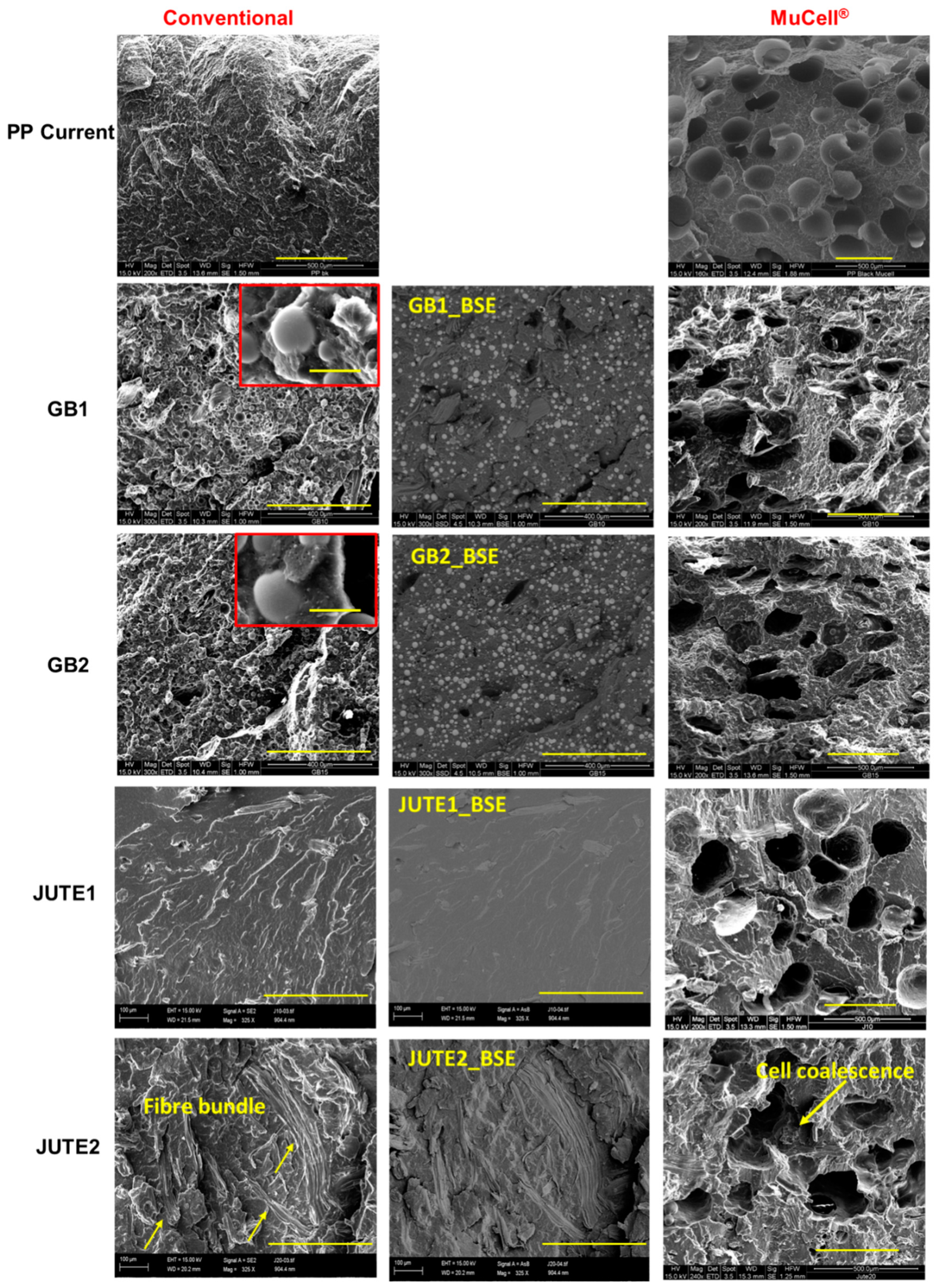
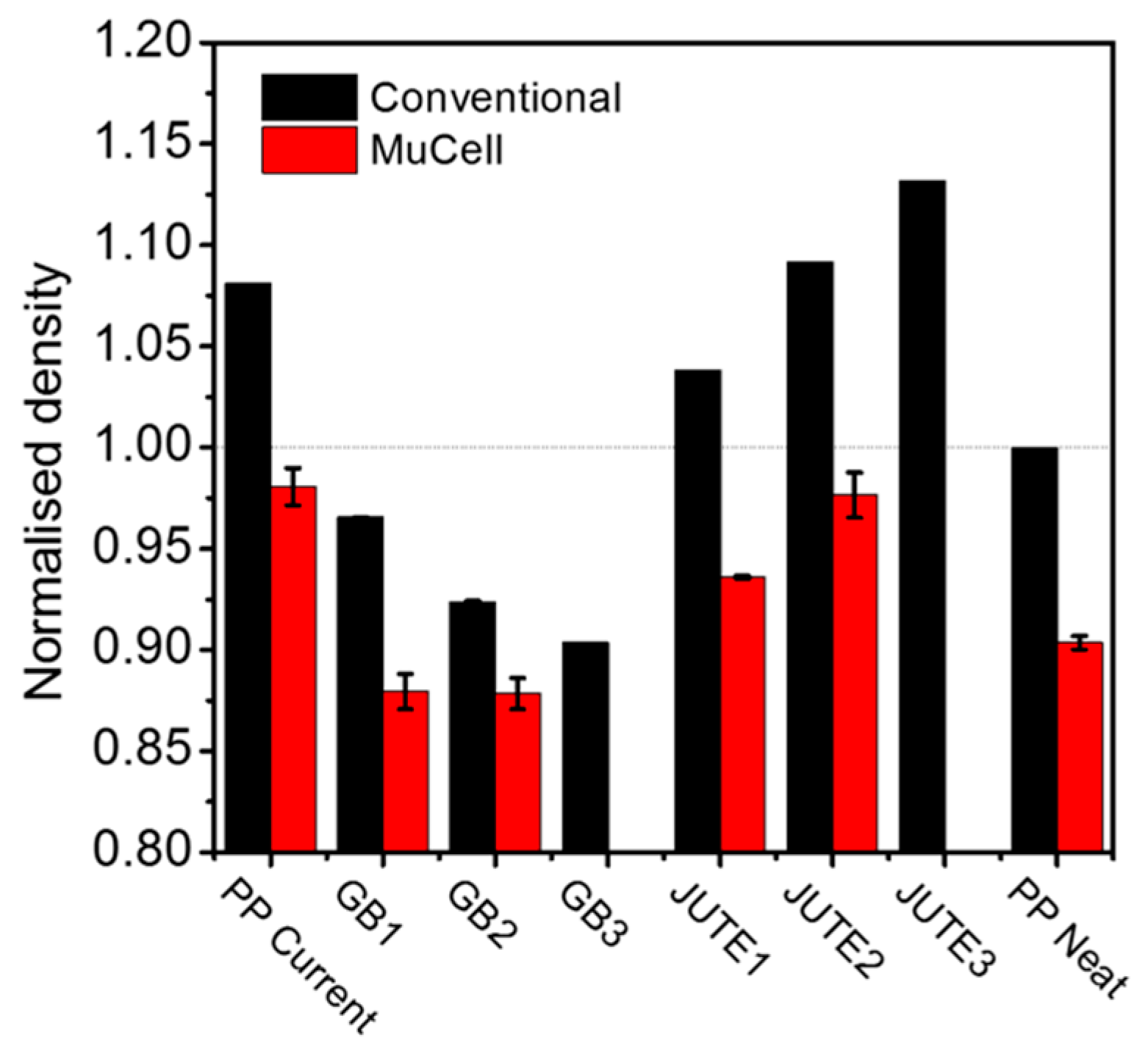
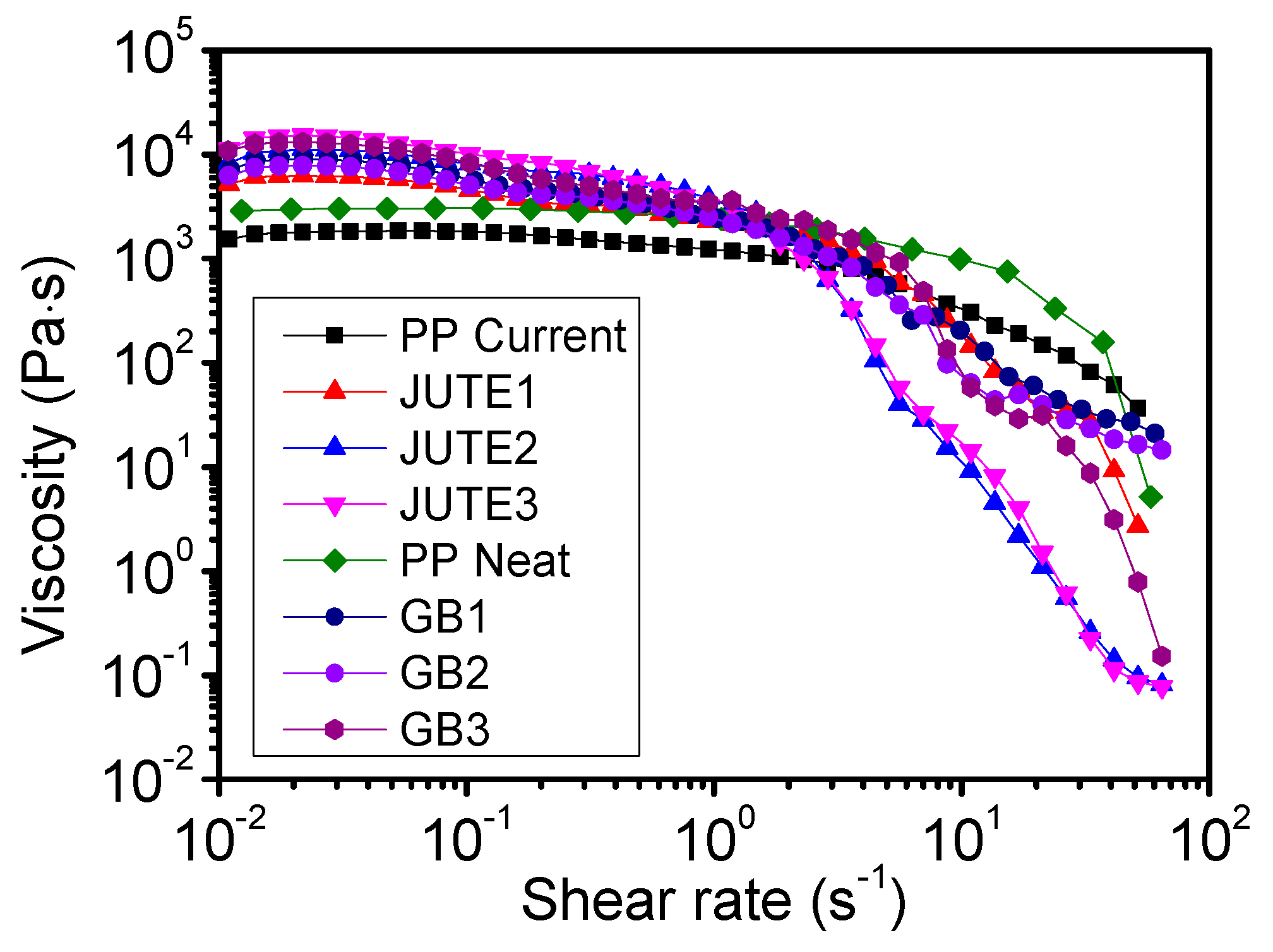
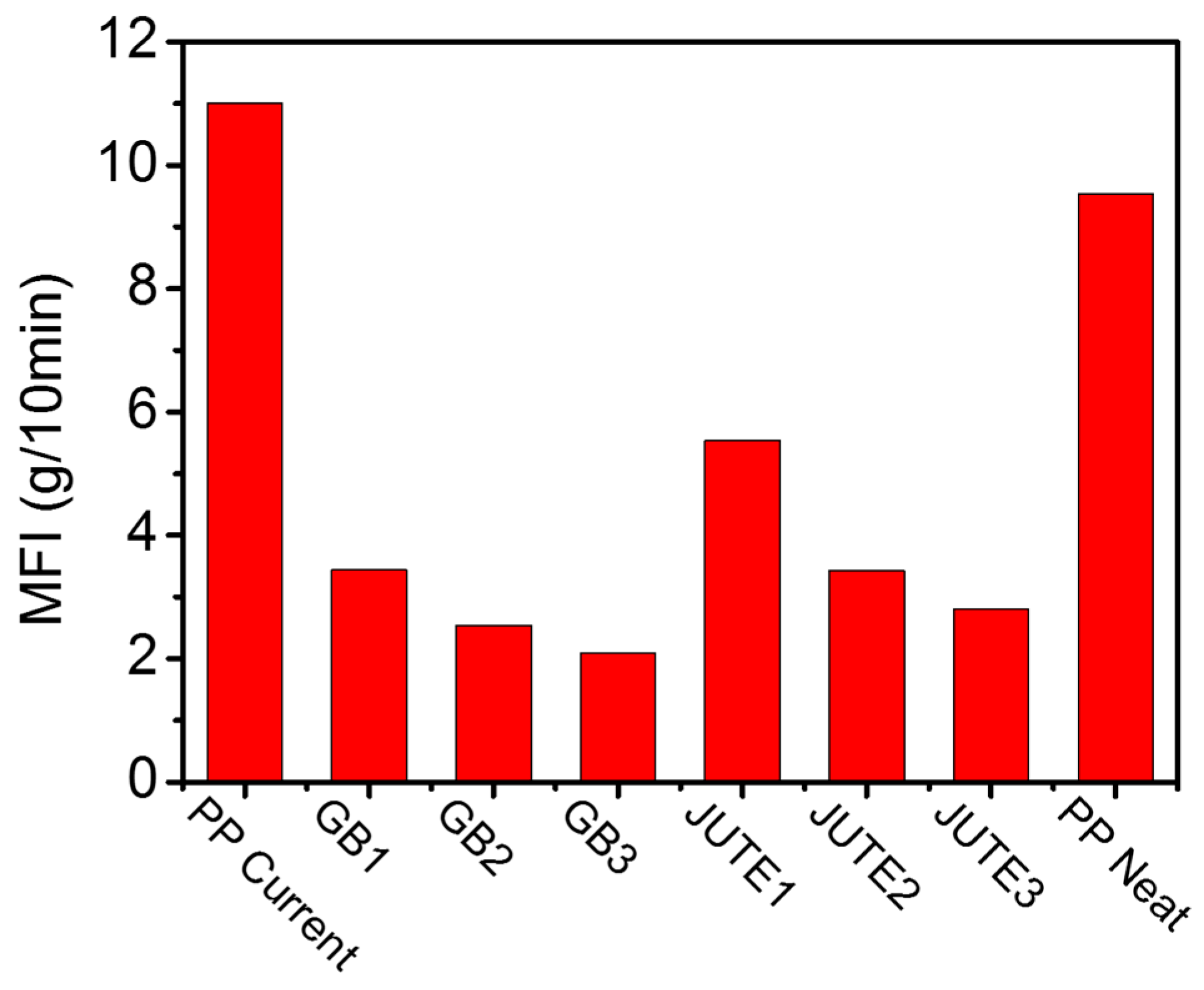

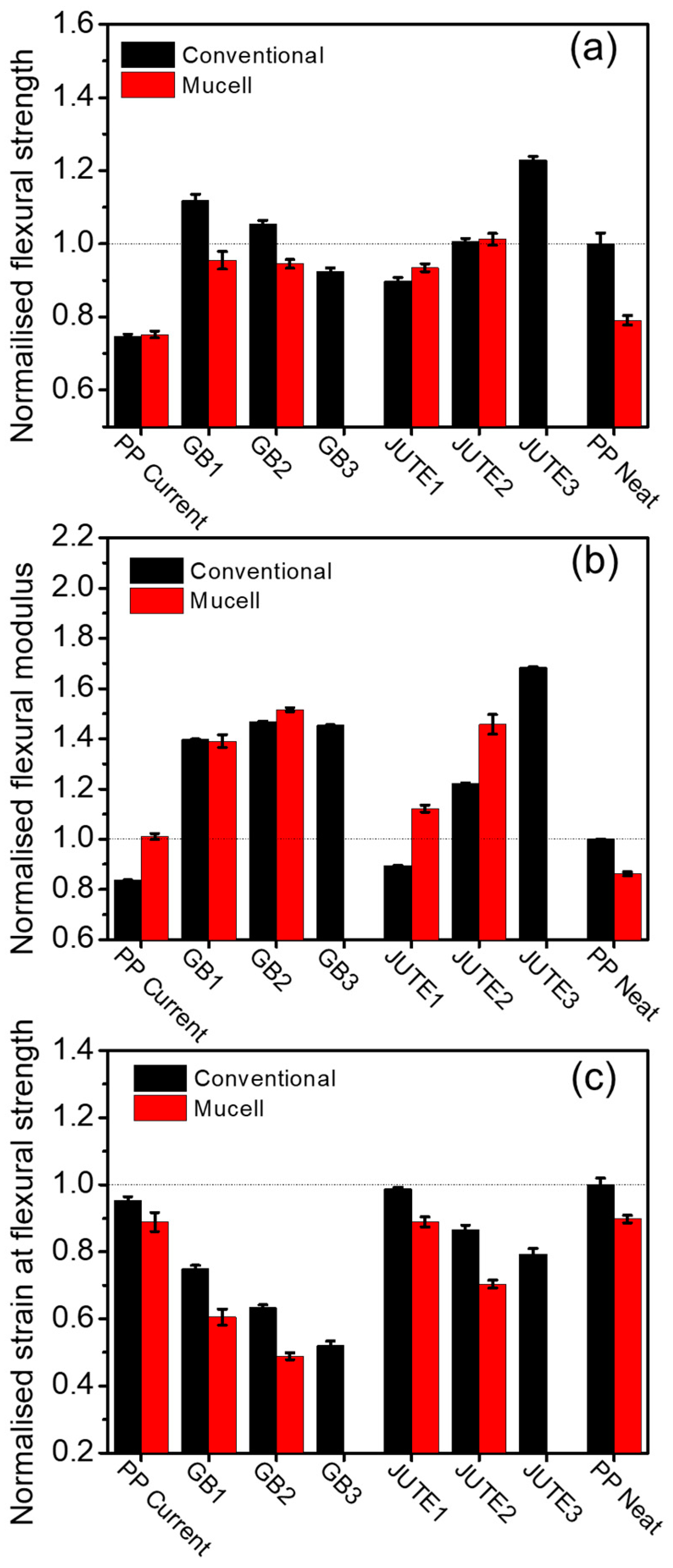
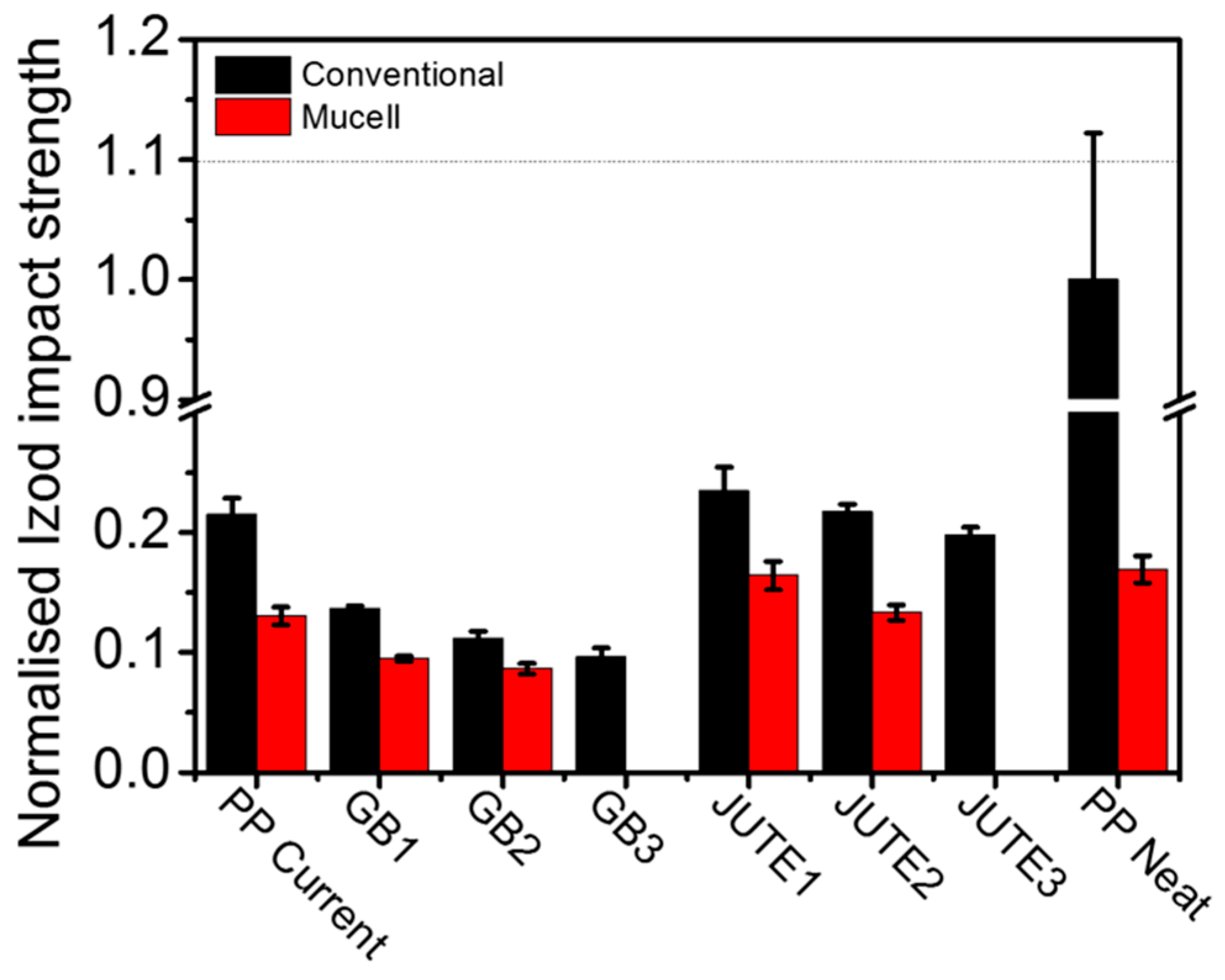
| Temperature (°C) | |||||||||
|---|---|---|---|---|---|---|---|---|---|
| Materials | Zone1 | Zone2 | Zone3 | Zone4 | Zone5 | Zone6 | Zone7 | Zone8 | Zone9 |
| HGB compounds | 190 | 190 | 190 | 190 | 200 | 200 | 200 | 200 | 200 |
| Jute compounds | 180 | 185 | 190 | 190 | 190 | 190 | 190 | 190 | 200 |
| Designation | PPC6742 (wt%) | HGB (wt%) | Jute (wt%) | Rubber Powder (wt%) | MA-PP (wt%) |
|---|---|---|---|---|---|
| GB1 | 78% | 10% | 10% | - | 2% |
| GB2 | 73% | 15% | 10% | - | 2% |
| GB3 | 68% | 20% | 10% | - | 2% |
| JUTE1 | 88% | - | 10% | - | 2% |
| JUTE2 | 74% | - | 20% | 4% | 2% |
| JUTE3 | 64% | - | 30% | 4% | 2% |
| Sample Name | Density Change Caused by Formulation (%) | Bulk Density Change Caused by Process (%) |
|---|---|---|
| PP Neat | 0 | −9.6 |
| GB1 | −3.5 | −8.9 |
| GB2 | −7.6 | −4.9 |
| GB3 | −9.6 | N/A |
| JUTE1 | +3.8 | −9.9 |
| JUTE2 | +9.2 | −10.6 |
| JUTE3 | +13.2 | N/A |
| PP Current | N/A | −9.3 |
Publisher’s Note: MDPI stays neutral with regard to jurisdictional claims in published maps and institutional affiliations. |
© 2020 by the authors. Licensee MDPI, Basel, Switzerland. This article is an open access article distributed under the terms and conditions of the Creative Commons Attribution (CC BY) license (http://creativecommons.org/licenses/by/4.0/).
Share and Cite
Tao, Y.; Hinduja, S.; Heinemann, R.; Gomes, A.; Bártolo, P.J. A Study of Physico-Mechanical Properties of Hollow Glass Bubble, Jute Fibre and Rubber Powder Reinforced Polypropylene Compounds with and without MuCell® Technology for Lightweight Applications. Polymers 2020, 12, 2664. https://doi.org/10.3390/polym12112664
Tao Y, Hinduja S, Heinemann R, Gomes A, Bártolo PJ. A Study of Physico-Mechanical Properties of Hollow Glass Bubble, Jute Fibre and Rubber Powder Reinforced Polypropylene Compounds with and without MuCell® Technology for Lightweight Applications. Polymers. 2020; 12(11):2664. https://doi.org/10.3390/polym12112664
Chicago/Turabian StyleTao, Yinping, Srichand Hinduja, Robert Heinemann, Anselmo Gomes, and Paulo Jorge Bártolo. 2020. "A Study of Physico-Mechanical Properties of Hollow Glass Bubble, Jute Fibre and Rubber Powder Reinforced Polypropylene Compounds with and without MuCell® Technology for Lightweight Applications" Polymers 12, no. 11: 2664. https://doi.org/10.3390/polym12112664
APA StyleTao, Y., Hinduja, S., Heinemann, R., Gomes, A., & Bártolo, P. J. (2020). A Study of Physico-Mechanical Properties of Hollow Glass Bubble, Jute Fibre and Rubber Powder Reinforced Polypropylene Compounds with and without MuCell® Technology for Lightweight Applications. Polymers, 12(11), 2664. https://doi.org/10.3390/polym12112664






